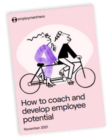Different Employee Learning Styles In The Workplace
Understand the different employee learning styles and discover practical tips to support every learner in your workplace for better engagement and results.

Every team is made up of individuals who absorb and retain information in different ways. For HR teams, recognising and supporting these different learning styles is more than just a nice-to-have. It plays a key role in driving employee engagement, boosting productivity and improving retention rates.
When employees receive information in a way that aligns with how they naturally learn, they are more likely to feel confident, capable and motivated. That’s why understanding learning styles matters so much in today’s workplace.
What are learning styles?
Learning styles are the unique ways people prefer to take in, process and remember new information. Some of us click with diagrams, others prefer to talk things out, while some just need to dive in and learn by doing.
In the workplace, learning styles shape how employees absorb training, tackle challenges and retain knowledge. It’s not about putting people in boxes, it’s about challenging the outdated idea that one-size-fits-all learning actually works. For HR teams, understanding learning styles is a smart way to personalise development, boost engagement and support every employee in doing their best work.
Common types of learning styles
Learning styles are generally categorised across several different models. Here, we’re going to dive into each of these methods and learning styles, but it’s important to remember that some people will have overlaps across several styles.
The VARK framework
The VARK framework is the most well-known and stands for: Visual, Aural, Read/Write and Kinesthetic. Each reflects a different way people prefer to absorb information. Visual learners respond best to images and diagrams, Aural learners to spoken explanations, Read/Write learners to text-based content, and Kinaesthetic learners to hands-on experiences. While many people have a dominant style, most benefit from a combination. This makes VARK a useful tool for designing inclusive and engaging workplace learning.
Visual learning style
Visual learners process and retain information best when it’s presented in a visually engaging way. Think charts, diagrams, mind maps, flowcharts, videos and colour-coded systems. People who learn best using this style tend to grasp concepts more easily when they can see how things fit together rather than just hear or read about them.
In the workplace they benefit from infographics in training sessions, process maps during onboarding and project dashboards that show workflows at a glance. If you’re rolling out new software, a screen-recorded walkthrough with visual annotations can be far more effective than a written manual. In meetings they might be the ones sketching out ideas or mapping out workflows to make sense of what’s being discussed. They also respond well to slide decks with strong visuals rather than bullet-heavy presentations.
Aural learning style
Aural learners absorb information through sound. They retain details from discussions, presentations and verbal instructions and are often quick to grasp tone and nuance. They may enjoy explaining things aloud to reinforce their understanding.
In the workplace, these learners benefit from team huddles, live Q&A sessions during training and voiceover-led e-learning modules. Consider recording training calls or providing podcasts for development topics. They may also thrive in roles that involve lots of client communication or collaborative brainstorming. Encouraging these people to summarise their understanding out loud during meetings or one-on-ones can also help reinforce retention.
Read/write learning style
Reading/writing learners prefer to interact with information through text. They’re at their best when they can read, take notes and rewrite or summarise ideas. They like to have written records they can refer back to and they often enjoy structuring their thoughts in writing.
In the workplace, these learners benefit from comprehensive documentation, policy manuals, checklists and written how-to guides. For training, offer downloadable transcripts alongside video or audio content and make sure important details are included in follow-up emails. They may be the ones who keep organised internal wikis, write detailed reports, or gravitate towards roles with structured, text-heavy communication.
Kinesthetic learning style
Kinesthetic learners learn by doing. They process information through physical activity, movement and direct experience. These are hands-on problem solvers who tend to lose focus in passive learning environments but thrive when they’re able to engage in the real-world.
In the workplace, kinaesthetic learners benefit from on-the-job training, shadowing opportunities, role play and interactive simulations. If you’re training them on a new tool, give them access to a test environment so they can explore it first-hand. During team development days they’re more likely to engage with breakout sessions, scenario-based workshops or activities that get them out of their chairs.
Kolb’s learning styles
Kolb’s learning styles are based on a four-stage experimental learning cycle. It highlights how people learn through a mix of experience, reflection, thinking and action. Kolb states that learners tend to gravitate toward one of four dominant styles: Diverging, Assimilating, Converging or Accommodating.
Diverging style
Diverging learners excel at viewing situations from multiple perspectives. They gather information, observe carefully and reflect deeply before taking action. They value feedback, enjoy brainstorming sessions, and tend to have strong emotional awareness.
In the workplace these learners benefit from open team discussions, idea-sharing workshops and retrospectives where they can reflect on what worked and what didn’t. They thrive in roles that involve listening and empathy, such as customer service or people management. Offering time for reflection after training or encouraging feedback-based activities helps these learners process and contribute more meaningfully.
Assimilating style
Assimilating learners prefer logical, structured approaches. They want to understand the theory behind the task and thrive when given detailed background information. These learners enjoy data, models and conceptual frameworks over hands-on experimentation.
In the workplace these learners benefit from reading internal reports, reviewing slide decks with structured content and accessing whitepapers or research. When rolling out new initiatives, provide them with the “why” behind the change. They may excel in analytical roles such as finance, data or strategy, where abstract thinking and precision are valued. Self-paced online modules and LMS resources with deep learning paths are ideal for this group.
Converging style
Converging learners like to apply ideas in a practical way. They’re problem solvers who enjoy technical tasks and prefer hands-on work with clear outcomes. They often focus more on the task than the people involved and efficiency over open-ended discussion.
In the workplace, converging learners benefit from structured tasks, skill-based training and real-world challenges. They’re the ones who’ll dive into a new platform and figure out how it works through experimentation. These learners shine when given project-based work, interactive product training or simulations where they can test solutions in a risk-free environment. They’re well-suited to roles in engineering, IT or operations.
Accommodating style
Accommodating learners are action-oriented and intuitive. They learn by doing and prefer hands-on experiences over analysis. These individuals often rely on gut instinct and learn best through trial and error, rather than theory or deep reflection.
In the workplace they benefit from live demonstrations, job shadowing, mentoring and real-time feedback. They’re quick to adapt to change and take initiative in practical tasks. Assign them to pilot new processes or be first adopters of tech rollouts. They tend to thrive in fast-paced roles like sales, marketing or project coordination where flexibility and quick decision-making are valued.
Honey and Mumford learning styles model
The Honey and Mumford learning styles model builds on Kolb’s experiential learning theory, adapting to four practical categories: Activist, Reflector, Theorist and Pragmatist. Each style reflects how individuals prefer to engage with new information; whether by jumping straight in, stepping back to observe, seeking logical explanations, or focusing on practical application.
Activist
Activists are energetic, open-minded learners who thrive on new experiences and learning by doing. They enjoy group activities, workshops and fast-paced environments and often jump into challenges with enthusiasm. They’re not big on lengthy planning—they prefer to try things out and learn from the outcome, even if it means making a few mistakes along the way.
In the workplace activists benefit from interactive training sessions, role play and team-building exercises. Give them opportunities to participate in pilot programs, hackathons, or brainstorming workshops where they can take immediate action and collaborate with others. They’re great candidates for ambassador roles during change initiatives, as they’re naturally engaged and eager to get involved.
Reflector
Reflectors prefer to step back, observe and analyse before making decisions. They like to gather insights, consider different perspectives and carefully reflect on their experiences. They don’t rush into situations, instead they want to think things through and process what they’ve learned before acting on it.
In the workplace they benefit from activities like one-to-one coaching, post-training reflection time and detailed feedback. Providing pre-reading materials or letting them review data ahead of meetings helps them contribute more confidently. They’re often the ones quietly picking up on team dynamics or identifying improvement areas others may miss. Think of them as your thoughtful strategists.
Theorist
Theorists are logical learners who like to understand the why behind everything. They look for structure, models and systems to make sense of new concepts. They want to fit what they’re learning into a bigger framework and often need to see the rationale before fully engaging.
In the workplace theorists benefit from training that includes models, flowcharts and structured learning paths. Provide background reading, research papers or explainer videos that give context to new initiatives. These learners excel in roles where strategic thinking and analysis are key, like planning, finance or operations and appreciate time to digest concepts before applying them.
Pragmatist
Pragmatists are practical, results-focused learners who want to see how something works in the real world. They’re less interested in theory and more concerned with what’s useful, applicable and efficient. Once they see how something can improve performance or solve a problem, they’re ready to try it out.
In the workplace they benefit from case studies, real-life examples, and tool-based training. They enjoy solving practical challenges and experimenting with new techniques, especially if there’s a clear Return on Investment (ROI). Assign them to process improvement projects or give them early access to test new platforms or workflows. They respond well to practical mentoring and “show me how” learning styles.
How to identify learning styles
Understanding how your employees learn best isn’t about putting them in boxes. It’s about unlocking their full potential. Identifying learning styles can help tailor development programs that actually stick, boosting engagement, confidence and performance. But how do you uncover someone’s preferred learning style in a busy workplace?
- Start with observation. Pay attention to how team members engage during training. Do they ask for written instructions, prefer hands-on walkthroughs or light up during discussions? These behaviours often hint at their learning preferences.
- Next, use direct feedback. One-on-one conversations or development check-ins are a great opportunity to ask employees how they like to learn. Do they enjoy reading guides, experimenting with new tools or talking ideas through with peers?
- Team surveys can also offer a broader view. Use quick pulse checks or learning preference questionnaires to gather insights across your workforce.
By combining insight, empathy and the right digital tools, you can create a learning culture where everyone feels empowered to grow.
How to support different learning styles
Not everyone learns the same way and that’s exactly why we celebrate it. The best learning and development strategies are flexible, practical and built with real people in mind. Supporting different learning styles isn’t about reinventing the wheel. It’s about revolutionising your approach by offering variety and giving your team options that truly work for them.
Start with blended learning. Mix things up with a combination of online courses, in-person sessions, videos, and hands-on tasks. That way, whether someone learns best by watching, reading, doing or listening, they’ve got a format that suits them.
For teams working remotely or in hybrid setups, adapting learning methods to fit flexible work styles is crucial. Check out our Hybrid work policy for tips on supporting learning wherever your people are.
It’s also worth switching up your training materials. As we explored earlier, visual learners will appreciate diagrams and short explainer videos. Aural learners benefit from group discussions or even a podcast-style approach. For those who prefer reading and writing, detailed guides and written exercises go a long way. And if someone learns by doing, give them space to practise, whether it’s through simulations, shadowing, or interactive workshops.
Peer learning is another powerful tool. Set up buddy systems, mentoring programs or knowledge-sharing sessions so people can learn from each other in ways that feel natural and practical. Tailoring learning approaches is a critical part of effective professional development, helping employees grow in ways that suit their unique style. All of which is made easier with a dedicated Learning Management System (LMS) to deliver varied training formats and track progress across your team.
Empower every learner with Employment Hero
Ready to turn these insights into action? With Employment Hero’s Learning Management System, it’s easy to support every learning style in your team. Create tailored training pathways, deliver content in multiple formats and track progress with real-time reporting. Whether your employees learn best through reading, watching, doing or collaborating, our LMS helps you build a culture of continuous learning that sticks.
Ready to unleash your team’s potential? Explore Employment Hero’s LMS today and see how flexible, effective learning can transform performance across your business.
Related Resources
-
 Read more: What is an LMS and how can it transform employee training programs?
Read more: What is an LMS and how can it transform employee training programs?What is an LMS and how can it transform employee training programs?
Find out if your LMS has what it takes to empower your team as they go for gold.
-
 Read more: 7 Great Employee Learning Program Examples
Read more: 7 Great Employee Learning Program Examples7 Great Employee Learning Program Examples
Want to know what great employee learning programs look like? Check out these seven examples!
-
 Read more: 10 benefits of training and development for your employees
Read more: 10 benefits of training and development for your employees10 benefits of training and development for your employees
Exploring the ways learning and development help your business grow and prosper.





















